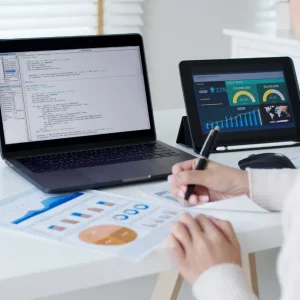Open Inc pitches into graphical user interface fray with Aspect
Open Inc, Colorado Springs, Colorado, which was established as a company last year, will be showing off its Aspect product at the Uniforum trade show, which opens in Dallas on January 22. Aspect is a high-level application programming interface designed to enable developers to write an application that will run under OSF/Motif, Open Look, Microsoft Windows and the Mac graphical user interfaces – as well as on character-based terminals. Applications written to the Aspect application programming interface can be tailored for a run-time environment for each of the interfaces. For example, an application with an Aspect user interface when linked with the Aspect Motif run-time produces a native Motif implementation. Aspect’s design tool stores specifications for the interface in a database. These specifications are not bound into the application, but are retrieved by the Aspect run-time system – a configuration that Open claims requires less of the interface to be hard-coded and allows changes to be made to the database without the need to re-compile applications. Aspect also enables the same applications to be run on character-based terminals as on systems with graphical user interfaces. This is because a character run-time version provides an event-driven manager for ASCII terminals implementing all features of the graphical environments, except for images, using the same application programming interface as the graphical run-times. Open Inc, a subsidiary of Pick-popper Via Systems Corp, claims Aspect is quite different from the offerings from the likes of Denver, Colorado-based XVT Software Inc. In the second quarter Aspect will be offered in Motif and character-based run-time versions running under Unix. A VMS implementation follows in the third quarter, with Macintosh, Microsoft Windows, OS/2 Presentation Manager and Open Look versions set for the end of the year. Open’s Howard Sweeney says the company hasn’t yet talked to any of the industry standards bodies currently looking for ways through the battleground of the competing Unix graphical user interfaces.
Sequent to announce 80486 multi- processor systems
Sequent Computer Systems Inc is expected to use the Uniforum show later this month to stage the announcement of its new Intel 80486-based multi-processor system, which features up to 24 central processing units and which it is scheduled to start delivering in March (CI No 1,535). The box will be the first in a new Sequent line and is planned to supersede the company’s current 80386-based family, which is to be retired gradually over time. Benchmark tests for the new boxes were still being run during the Christmas holiday, but Sequent was expecting at least a 20% improvement over its current 250 transactions per-second performance claim. Sequent says it has between 2,500 and 3,000 80386 multi-processing systems in the field.
Solarix Systems Inc to preview Intel- based X-terminal
Solarix Systems Inc, the would-be Sparc systems builder, is expecting to preview a new X-terminal prototype at Uniforum that it has developed in-house. Firm specifications are still scarce, but the new commercially geared 14 line, dubbed the CX-14, will house an 80286 or 80386 chip and 4Mb memory, connect to any host supporting TCP/IP, and offer 256 colours at 1024 by 768 pixel resolution. Pricing will go below $1,900. Solarix, which is still struggling to get entry-level models of its overdue Solarix/4 PW+ Sparc system out, says that it is now in alpha test with the base line 18 MIPS, 25MHz boxes and should be delivering volume quantities in March or April. It will be distributing them through unidentified OEM customers, and via some regional US distributors and large key resellers that it’s still in discussions with. A Sparc server that had been expected this quarter has been postponed until probably the third quarter of this year, the company said.
Newcomer Clarity Software to reveal Rapport office tools
Also at Uniforum, Clarity Software, an unknown start-up in Mou
ntain View, California, is supposed to unveil Rapport, a brand new suite of Unix-based object-oriented office tools that includes a compound document editor, spreadsheet, presentation graphics and advanced electronic mail. Clarity – in business for a year – fancies the software, its first product, could be the long-sought killer application that will propel Unix out of the technical niche and into the general-purpose computing big time. Despite these hopes, the company will start by selling the what you see is what you get product into the technical workstation market, with visions of eventually targeting MS-DOS and Apple Macindosh users that want to move to more powerful computing environments. Rapport reportedly runs under both the Motif and Open Look graphical user interfaces on DEC, Hewlett-Packard-Apollo, IBM, Sun Microsystems and Silicon Graphics kit, as well as on X-terminals. Clarity, which prides itself on Rapport’s openness and wide appeal, claims older office automation competitors like Q-Office and Uniplex have been rendered obsolete by hardware and operating system advances such as graphical user interfaces, and that younger competition like Bolt, Beranek & Newman Inc’s Slate or Applix Inc’s Alis are either closed and proprietary packages or focused on a single task. Clarity lists the Macintosh-like interface, the ability to work with other Unix software such as Framemaker, Wingz, Lotus 1-2-3 or custom applications as though they were native, and the ability to exchange editable mixed-media documents with non-Rapport users on any Unix, MS-DOS or Macintosh system as Rapport’s winning features. Rapport is priced at $900 per user, with converters for transparent access to other systems priced separately. The Unix, MS-DOS micro and Mac Packs cost $200 each.






